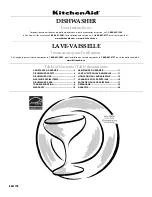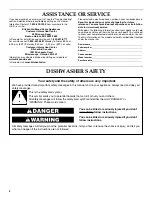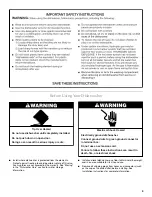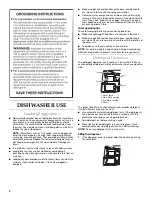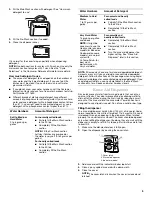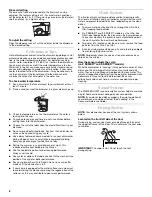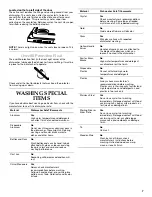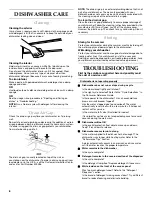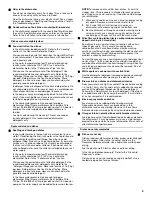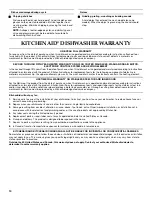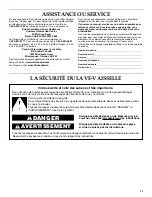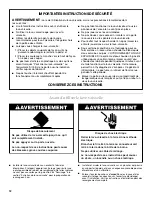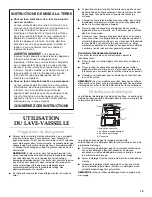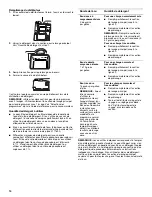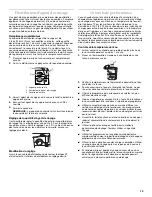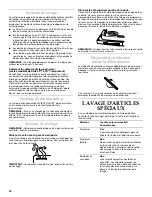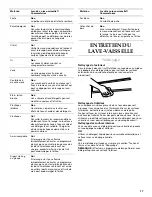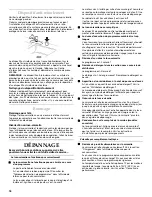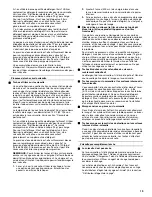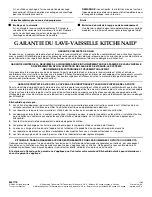
9
■
Odor in the dishwasher
Are dishes washed only every 2 or 3 days? Run a rinse cycle
once or twice a day until you have a full load.
Does the dishwasher have a new plastic smell? Run a vinegar
rinse as described in “Spotting and filming on dishes” later in
this Troubleshooting guide.
■
Condensation on the kitchen counter (built-in models)
Is the dishwasher aligned with the countertop? Moisture from
the vent in the dishwasher console can form on the counter.
Refer to the Installation Instructions for more information.
Dishes are not completely clean
■
Food soil left on the dishes
Is the dishwasher loaded correctly? Refer to the “Loading”
section in the Consumer Reference Guide.
Did you choose the cycle that describes the most difficult soil
in your dishwasher? If you have some items with heavier soils,
use a heavier cycle.
Is the water temperature too low? For best dishwashing
results, water should be 120°F (49°C) as it enters the
dishwasher. Refer to the “Performance Tips” section.
Did you use the correct amount of fresh detergent? Use
recommended dishwasher detergents only. Refer to the
“Detergent Dispenser” section. Never use less than 1 tb (15 g)
per load. Detergent must be fresh to be effective. Store
detergent in a cool, dry area. Heavy soil and/or hard water
generally require extra detergent.
Is detergent caked in dispenser? Use fresh detergent only. Do
not allow detergent to sit for several hours in a wet dispenser.
Clean dispenser when caked detergent is present.
Is the pump or spray arm clogged by labels from bottles and
cans? If you wash bottles and cans in your dishwasher, check
for labels clogging the pump or spray arm.
Is the home water pressure high enough for proper
dishwasher filling? Home water pressure should be 20 to
120 psi (138 to 828 kPa) for proper dishwasher fill. A booster
pump on the water supply can be added if pressure is
too low.
Are high suds slowing the wash arm? Never use soap or
laundry detergents. Use recommended dishwasher
detergents only.
Spots and stains on dishes
■
Spotting and filming on dishes
Is your water hard or is there a high mineral content in your
water? Conditioning the final rinse water with a liquid rinse aid
helps eliminate spotting and filming. Keep the rinse aid
dispenser filled. Always use a high-temp option. If your water
hardness is 13 grains or above, it is strongly recommended
that you install a home water softener. If you do not wish to
drink softened water, have the softener installed onto your hot
water supply.
Is the water temperature too low? For best dishwashing
results, water should be 120°F (49°C) as it enters the
dishwasher. Refer to the “Performance Tips” section.
Did you use the correct amount of effective detergent? Use
recommended dishwasher detergents only. Refer to the
“Detergent Dispenser” section. Never use less than 1 tb (15 g)
per load. Detergent must be fresh to be effective. Store
detergent in a cool, dry area. Heavy soil and/or hard water
generally require extra detergent.
Is the home water pressure high enough for proper
dishwasher filling? Home water pressure should be 20 to
120 psi (138 to 828 kPa) for proper dishwasher fill. A booster
pump on the water supply can be added if pressure is too low.
NOTE: To remove spots and film from dishes, try a white
vinegar rinse. This procedure is intended for occasional use
only. Vinegar is an acid, and using it too often could damage
your dishwasher.
1. Wash and rinse dishes. Use an air-dry or an energy saving
dry option. Remove all silverware or metal items.
2. Put 2 cups (500 mL) white vinegar in a glass or
dishwasher-safe measuring cup on the bottom rack.
3. Run the dishwasher through a complete washing cycle
using an air-dry or an energy saving dry option. Do not
use detergent. Vinegar will mix with the wash water.
■
Silica film or etching (silica film is a milky, rainbow-colored
deposit; etching is a cloudy film)
Sometimes there is a water/chemical reaction with certain
types of glassware. This is usually caused by some
combination of soft or softened water, alkaline washing
solutions, insufficient rinsing, overloading the dishwasher, and
the heat of drying. It might not be possible to prevent the
problem, except by hand washing.
To slow this process use a minimum amount of detergent but
not less than 1 tb (15 g) per load. Use a liquid rinse aid and
underload the dishwasher to allow thorough rinsing. Silica film
and etching are permanent and cannot be removed. Do not
use heated drying.
■
White spots on cookware with nonstick finish
Has the dishwasher detergent removed cookware seasoning?
Reseason cookware after washing in the dishwasher.
■
Brown stains on dishes and dishwasher interior
Does your water have high iron content? Rewash dishes using
1-3 tsp (5-15 mL) of citric acid crystals added to the covered
section of the detergent dispenser. Do not use detergent.
Follow with a Normal wash cycle with detergent. If treatment
is needed more often than every other month, the installation
of an iron removal unit is recommended.
■
Black or gray marks on dishes
Are aluminum items rubbing dishes during washing?
Disposable aluminum items can break down in the
dishwasher and cause marking. Hand wash these items.
Remove aluminum markings by using a mild abrasive cleaner.
■
Orange stains on plastic dishes or dishwasher interior
Are large amounts of tomato-based foods on dishes placed in
the dishwasher? It may be necessary to use a stain removal
product to remove stains from your dishwasher. Stains will not
affect dishwasher performance.
Dishes do not dry completely
■
Dishes are not dry
Did you load your dishwasher to allow proper water drainage?
Do not overload. Refer to the “Loading” section in the
Consumer Reference Guide. Use a liquid rinse aid to speed
drying.
Are the plastics wet? Plastics often need towel drying.
Is the rinse aid dispenser empty? Refer to the “Rinse Aid
Dispenser” section.
Did you use an air-dry or energy-saving dry option? Use a
heated drying option for dryer dishes.

